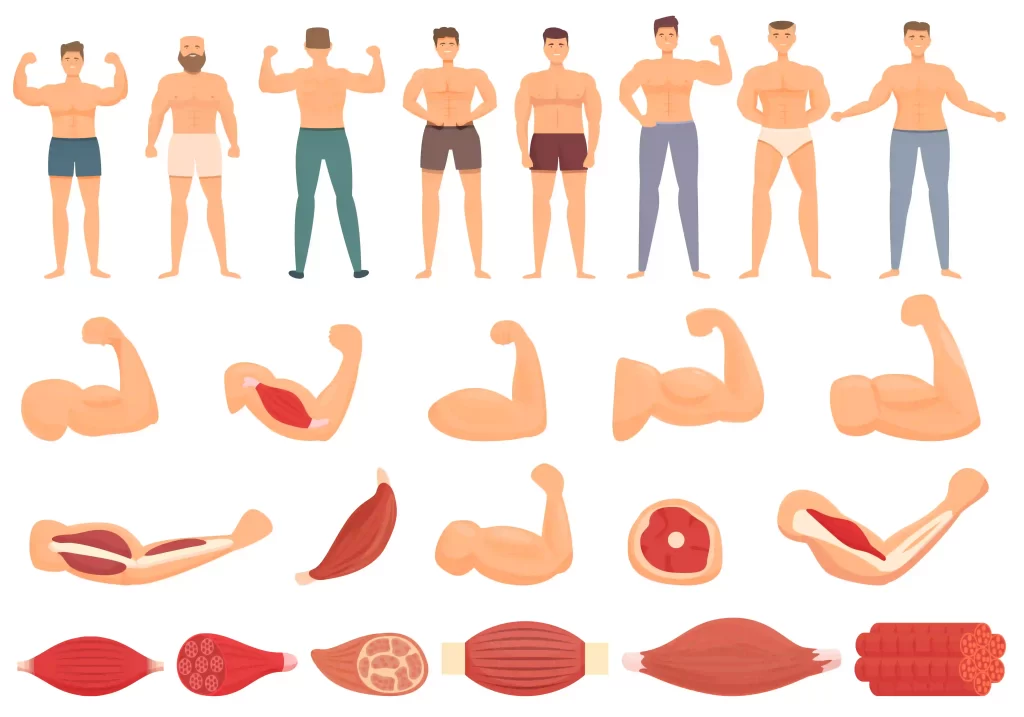Building muscle is a journey that requires dedication, consistency, and patience. As someone who’s embarked on this path, I understand the eagerness to see results quickly. However, it’s crucial to recognize that muscle growth follows a timeline influenced by various factors.
Let’s delve into the intricacies of this process and how patience plays a pivotal role in achieving your desired physique.
Factors Affecting Muscle Growth
When it comes to gaining muscle, several factors come into play:
- Genetics: Each individual’s genetic makeup influences their muscle-building potential. While some may see rapid gains, others may progress slower.
- Nutrition: Providing your body with adequate nutrients, especially protein, is essential for muscle repair and growth.
- Training Intensity and Frequency: The intensity and frequency of your workouts determine the stimulus your muscles receive, promoting growth.
- Rest and Recovery: Muscles need time to recover and grow stronger after training. Insufficient rest can hinder progress.
Phases of Muscle Growth
Muscle growth occurs in distinct phases:
- Initial Adaptation Phase: In the initial weeks of training, your body adapts to the stress placed on the muscles, leading to neural adaptations and some initial gains in strength.
- Hypertrophy Phase: This is where muscles undergo significant growth in size in response to consistent training and proper nutrition.
- Strength Phase: As your muscles grow, they also become more robust, allowing you to lift heavier weights and further stimulate muscle growth.
Timeline to Muscle Growth
It’s essential to understand that muscle growth takes time. While some may experience noticeable gains within a few weeks, significant progress often occurs over months and years. Realistic expectations are crucial to staying motivated on your fitness journey.
Patience in Muscle Building
Building muscle requires patience, both physically and mentally. It’s easy to become discouraged when progress seems slow, but staying patient is crucial for long-term success. Here’s how to cultivate patience:
- Mental Resilience: Focus on the process rather than fixating on immediate results. Trust in your training and nutrition plan.
- Tracking Progress: Keep track of your workouts, measurements, and strength gains. Seeing tangible progress, no matter how small, can boost motivation.
- Avoiding Comparison: Everyone’s journey is unique. Avoid comparing your progress to others, and stay focused on your goals.
Strategies for Optimal Progress
To optimize muscle growth and progress effectively, consider the following strategies:
- Progressive Overload: Continuously challenge your muscles by increasing your workouts’ weight, reps, or intensity.
- Nutrition and Supplementation: Consume a balanced diet of protein, carbohydrates, and healthy fats. Supplements can complement your diet but shouldn’t replace whole foods.
- Adequate Rest and Recovery: Ensure you sleep enough and allow your muscles to recover between workouts.

Understanding Plateaus
Plateaus are common in muscle building, where progress stalls despite consistent effort. Understanding the causes of plateaus and how to overcome them is essential:
- Common Causes: Plateaus can be caused by factors such as overtraining, inadequate nutrition, or lack of variety in your workouts.
- Overcoming Plateaus: Introduce changes to your routine, such as altering your exercises, increasing volume, or incorporating new training techniques.
Incorporating Variety
Adding variety to your workouts is essential for continued progress:
- Importance of Changing Routines: Regularly change your exercises, rep ranges, and training techniques to prevent your body from adapting and hitting a plateau.
- Preventing Adaptation: Keep your muscles guessing by introducing new challenges and stimuli.
Listening to Your Body
Listening to your body is crucial for avoiding injuries and burnout:
- Signs of Overtraining: Pay attention to signs of overtraining, such as persistent fatigue, decreased performance, or increased susceptibility to illness.
- Importance of Deload Weeks: Incorporate deload weeks into your training regimen to allow your body to recover and prevent overtraining.
Celebrating Milestones
Celebrating small victories along the way can keep you motivated:
- Small Victories: Whether lifting a heavier weight or seeing improvements in your physique, celebrate every milestone, no matter how minor.
- Long-Term Mindset: Remember that muscle building is a marathon, not a sprint. Stay committed to your goals, and celebrate progress, no matter how gradual.
Staying Motivated
Maintaining motivation throughout your muscle-building journey is essential:
- Setting Goals: Set specific, measurable, and achievable goals to keep you focused and motivated.
- Finding Support: Surround yourself with a supportive community or workout partner who can encourage and motivate you.
Adjusting Expectations
As you progress on your fitness journey, it’s essential to adjust your expectations:
- Age and Muscle Growth: Understand that muscle-building potential may decrease with age. Focus on maximizing your progress within your capabilities.
- Adapting to Setbacks: Setbacks are a natural part of any journey. Learn from them, adapt your approach, and keep moving forward.
The Role of Recovery
Recovery is just as important as training:
- Sleep: Aim for 7-9 hours of quality sleep per night to support muscle repair and growth.
- Nutrition: Fuel your body with nutrient-dense foods to support recovery and optimize performance.
- Active Recovery: Incorporate yoga, stretching, or light cardio to promote blood flow and reduce muscle soreness.
Avoiding Burnout
Preventing burnout is crucial for long-term success:
- Balancing Training and Life: Find a balance between your fitness goals and other aspects of your life. Overcommitting to training can lead to burnout.
- Importance of Rest Days: Incorporate rest days into your routine to allow your body and mind to recharge.

Conclusion
Building muscle is a journey that requires patience, perseverance, and dedication. By understanding the timeline to muscle growth, cultivating patience, and implementing effective strategies, you can achieve your fitness goals and build a robust and resilient physique. Stay focused, stay consistent, and trust in the process.
FAQs
How long does it take to see noticeable muscle growth?
The timeline for muscle growth varies depending on genetics, nutrition, and training intensity. While some may see results within a few weeks, significant progress often occurs over months and years of consistent effort.
What should I eat to promote muscle growth?
To support muscle growth, consume a balanced diet of protein, carbohydrates, and healthy fats. Lean meats, fish, eggs, dairy products, fruits, vegetables, and whole grains benefit muscle repair and growth.
Can I build muscle without lifting weights?
While resistance training is the most effective way to build muscle, bodyweight exercises, resistance bands, and other forms of resistance can also stimulate muscle growth, especially for beginners or those unable to access gym equipment.
How often should I change my workout routine?
Regularly introducing variety into your workouts to prevent plateaus and keep your muscles challenged is essential. Consider changing your routine every 4-6 weeks to prevent adaptation.
Is it normal to plateau during muscle building?
Plateaus are common in muscle building, where progress stalls despite consistent effort. By adjusting your training, nutrition, and recovery strategies, you can overcome plateaus and continue progressing toward your goals.

